Enjoy the centuries-old tradition of chanoyu, the Japanese tea ceremony, in the cultural heart of Kyoto. Guided by a knowledgeable tea master, this 90-minute experience offers an intimate journey into the meticulous preparation and appreciation of matcha green tea and wagashi sweets. Guests don traditional kimonos, learn the etiquette, and discover the deep significance behind each elegant movement. Limited to just six travelers, this serene ritual promises a tranquil reflection on Japan’s rich heritage.
Key Points
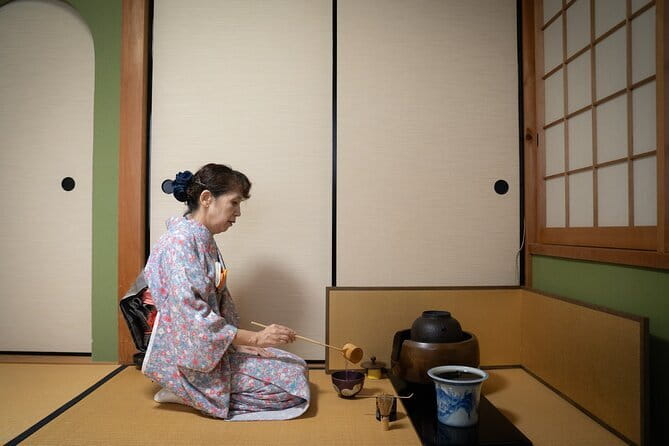
- Immersive 90-minute experience offering a glimpse into the centuries-old Japanese tradition of chanoyu, including matcha green tea and wagashi.
- Participants wear traditional kimonos and learn about the cultural significance and etiquette from a knowledgeable guide in a personalized setting.
- The tea ceremony takes place at a designated location inside a venue in the Shimogamo area of Kyoto, with participants returning to the original meeting point.
- Priced from $34.44 per person, with a lowest price guarantee, free cancellation, and an option to reserve and pay later.
- The experience is suitable for most travelers, but not recommended for those with back problems due to the kneeling involved.
Overview of the Tea Ceremony Experience
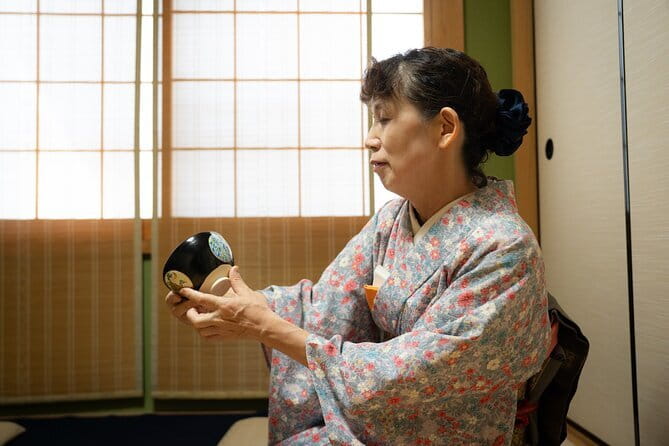
The tea ceremony experience in Kyoto offers participants an immersive glimpse into the centuries-old Japanese tradition of chanoyu.
Held in an intimate, traditional setting, the 90-minute experience includes preparation and presentation of matcha green tea and wagashi, delicate Japanese sweets.
A knowledgeable guide leads guests through the intricate steps, sharing the cultural significance and etiquette.
Participants don traditional kimonos and witness the host’s meticulous movements as they savor the flavors and aromas.
Limited to six travelers, the ceremony provides a serene, personalized encounter with this refined art form.
You can also read our reviews of more tours and experiences in Kyoto.
Meeting Point and Directions
To reach the Tea Ceremony Experience Chisato, guests should look for a sign that says "Chisato" and press the bell for entry.
The venue is located at 67-23 Shimogamo Matsunokichō, Sakyo Ward, Kyoto, 606-0816, Japan.
Customers will find the meeting point in the Shimogamo area of Kyoto.
Once inside, the tea ceremony takes place at the designated location.
At the end of the experience, participants return to the original meeting point where the activity began.
Pricing and Offers
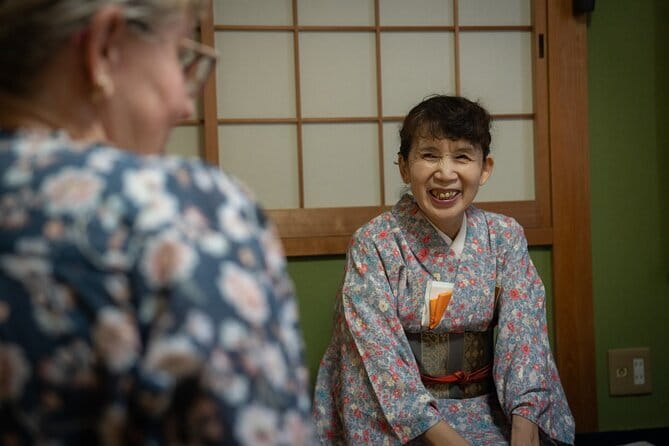
The Tea Ceremony Experience in Kyoto is priced from $34.44 per person, originally $40.52, offering a savings of $6.08.
This lowest price guarantee ensures travelers get the best deal. With free cancellation up to 24 hours before the start, the experience can be booked with confidence.
Travelers can also reserve their spot now and pay later, providing flexibility.
The Tea Ceremony Experience includes matcha, traditional Japanese sweets, a guide, and even a kimono, offering an immersive cultural experience in Kyoto for a budget-friendly price.
Accessibility and Recommendations
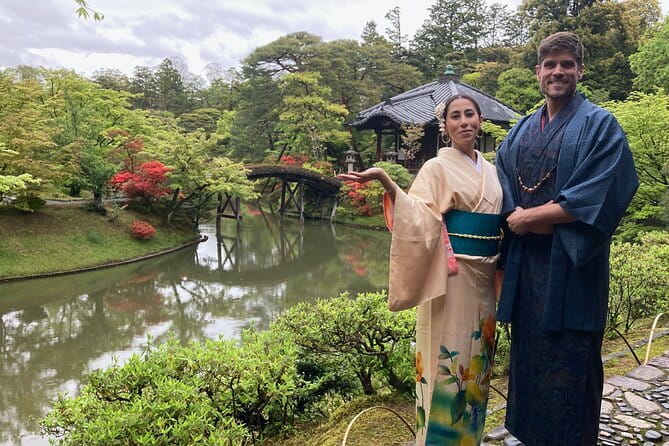
Although the Tea Ceremony Experience isn’t wheelchair accessible, it’s still suitable for most travelers.
The activity isn’t recommended for those with back problems, as participants must kneel on the floor for an extended period. However, if you don’t have mobility issues, you’ll find the experience comfortable and enjoyable.
The setting is serene, and the ceremony is conducted with precise movements and attention to detail. The guide will provide instructions and ensure you fully learn about the traditional Japanese tea ritual.
What to Expect During the Tea Ceremony
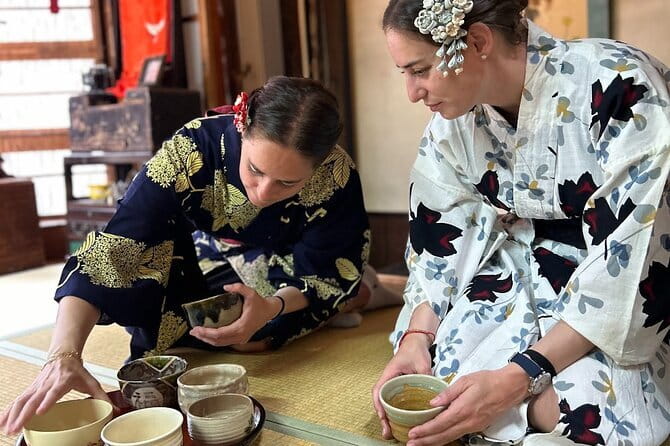
When participants arrive at the Tea Ceremony Experience Chisato, they’re greeted by a traditional Japanese tea master who guides them through the serene ritual.
The tea master demonstrates the precise movements and meticulous preparation of matcha, the powdered green tea. Participants then:
- Admire the intricate ceramic tea bowl and whisk used in the ceremony
- Learn the significance of each step in the tea preparation process
- Appreciate the beauty of the accompanying wagashi, delicate Japanese sweets
- Savor the earthy, umami-rich flavor of the frothy matcha tea
- Reflect on the traditions and tranquility of the centuries-old tea ceremony.
The Art of Matcha Preparation
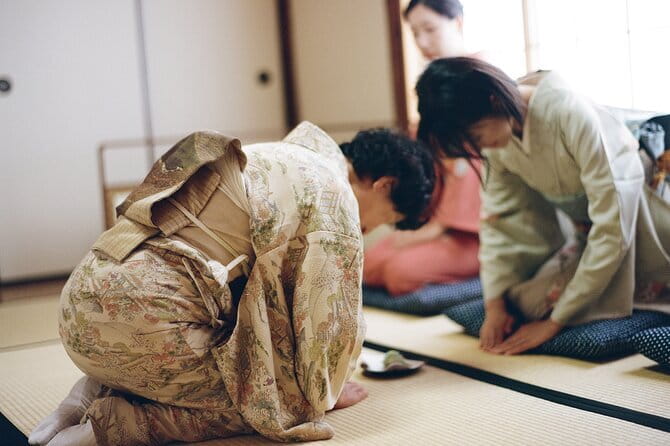
As the tea master deftly prepares the matcha, participants can’t help but be captivated by the graceful movements and meticulous attention to detail.
With a bamboo whisk, the tea master delicately incorporates the vibrant green powder into hot water, creating a frothy, emerald elixir. The rhythmic whisking motion is both mesmerizing and meditative.
Once the matcha is ready, the master carefully serves each guest, ensuring the temperature and consistency are perfect.
Sipping the earthy, umami-rich liquid, participants savor the harmonious blend of flavors and the calming ambiance of the traditional Japanese tea ceremony.
Indulging in Wagashi Sweets
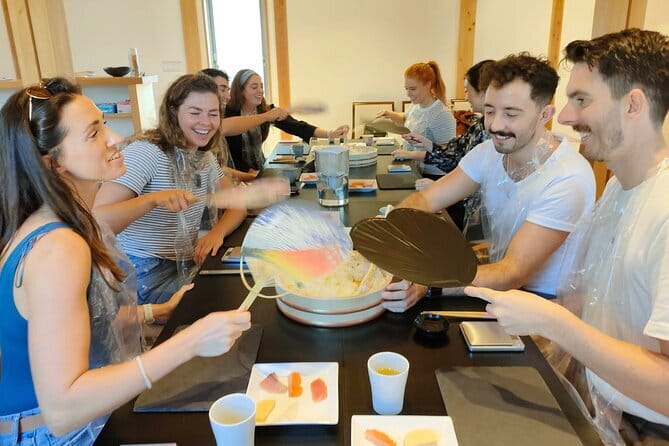
Alongside the soothing matcha, guests partake in an array of delicate Wagashi sweets.
These traditional Japanese confections aren’t merely desserts – they’re edible works of art, meticulously crafted to represent the changing seasons and natural world.
Wagashi come in a variety of shapes and flavors, including:
- Sakura (cherry blossom) – delicate pink sweets evoking the fleeting beauty of spring
- Tsukimi (moon-viewing) – round, white sweets reminiscent of the full harvest moon
- Momiji (maple leaf) – maple-flavored sweets with a vibrant red-orange hue
- Kuromitsu (black honey) – rich, molasses-like confections
- Kinako (toasted soybean flour) – nutty, golden-hued bites
Savoring these edible artforms enhances the meditative tea ceremony experience.
Dressing in Traditional Kimono
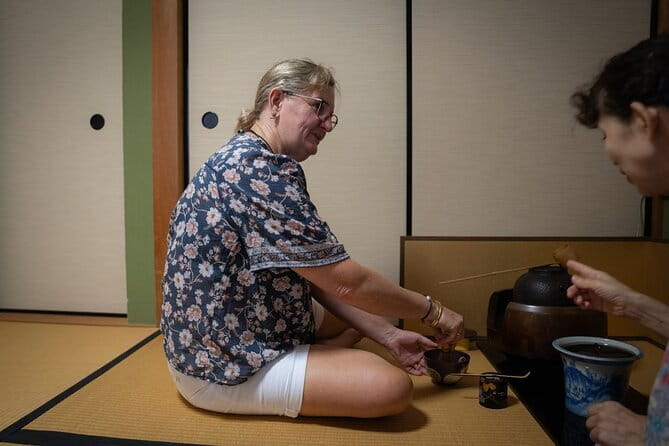
Participants don don traditional kimono as part of the immersive tea ceremony experience.
Vibrant fabrics, intricate patterns, and elegant silhouettes transform guests into the sights and sounds of historic Japan. Skilled kimono assistants guide participants through the precise steps, ensuring a proper and respectful fitting.
The soft rustle of silk and the careful tying of obi belts transport guests back in time. Slipping into the kimono, participants feel a newfound sense of cultural connection, ready to fully engage with the serene ritual ahead.
This thoughtful touch elevates the overall experience, immersing guests in the essence of Japanese tradition.
Frequently Asked Questions
Can I Take Photos During the Tea Ceremony?
You’re generally not allowed to take photos during the tea ceremony, as it’s considered disruptive to the tranquil atmosphere. However, you may be able to take a few photos before or after the ceremony with the host’s permission.
Is the Tea Ceremony Experience Suitable for Children?
The tea ceremony experience may not be suitable for young children. It requires attentive participation, and the formal setting and quiet atmosphere may be challenging for some kids. The experience is best suited for adults and older children who can engage respectfully.
Do I Need to Bring My Own Tea Utensils?
No, participants don’t need to bring their own tea utensils. The tea ceremony experience includes use of all necessary equipment, like the traditional tea bowl, tea whisk, and tea caddy. Everything is provided as part of the guided experience.
Can I Customize the Type of Wagashi Sweets Served?
No, you can’t customize the wagashi sweets served. The experience includes a set selection of traditional Japanese sweets that are paired with the matcha tea. The host selects the wagashi to complement the tea ceremony.
Is the Kimono Provided for the Entire Duration of the Experience?
The kimono is provided for the entirety of the tea ceremony experience. Guests can wear the traditional Japanese attire throughout the session, which includes the matcha tea preparation, wagashi sweets, and guidance from the experienced host.
Recap
The Tea Ceremony Experience in Kyoto offers a serene glimpse into Japan’s rich cultural heritage. Participants don traditional kimonos and learn the art of matcha preparation from a knowledgeable tea master. This 90-minute ritual, limited to six travelers, promises a tranquil reflection on the significance and etiquette of chanoyu. Indulge in exquisite wagashi sweets as you appreciate the beauty of the ceramic tea bowls, enjoying this centuries-old tradition.
More Tour Reviews in Kyoto
- The Art of Geisha: Exclusive Show & Traditional Japanese Game
- Tea Ceremony With Kimono and Professional Photoshoot in Kyoto
- Kyoto Arashiyama Bamboo Forest Hidden Hiking Tour
- Kyoto Early Morning Walking Tour: Nature & History
- Small-Group Dinner Experience in Kyoto With Maiko and Geisha
- Private Kyoto Night Tour: Historic Walk at Gion and Fushimi
Not for you? Here's more things to do in Kyoto we have recnetly reviewed
- 5 Best Cruises And Boat Tours In Kyoto
- 14 Best Dining Experiences In Kyoto
- 20 Best Full-Day Tours In Kyoto
- 5 Best 2 Day Tours In Kyoto
- 2 Best 4 Day Tours In Kyoto
- 20 Best Photography Experiences In Kyoto
- 13 Best Dinner Tours In Kyoto
- 25 Best Food Tours In Kyoto
- 14 Best Lunch Experiences In Kyoto
- Kyoto Bus Tour: Iconic KInkakuji, Ginkakuji, Kiyomizu Temple (AW)
- Kyoto Bus Tour: Arashiyama, Kinkaku-ji Review
- Gyoza Cooking Class in Kyoto: Traditional Japanese Dumplings
